Zoom
Trash

Space Fan News #43: Kepler-22b; Biggest Black Holes EVER!; Swift Sees a Strange GRB. US military pays SETI to check Kepler-22b for aliens. Preparing for successful VDI implementation The Search for Extra Terrestrial Intelligence (SETI) has announced that it is back in business checking out the new habitable exoplanets recently discovered by NASA's Kepler space telescope to see if they might be home to alien civilisations.

The cash needed to restart SETI's efforts has come in part from the US Air Force Space Command, who are interested in using the organisation's detection instruments for "space situational awareness". "This is a superb opportunity for SETI observations," said Jill Tarter, the Director of the Center for SETI Research, in a statement issued yesterday.
"For the first time, we can point our telescopes at stars, and know that those stars actually host planetary systems - including at least one that begins to approximate an Earth analog in the habitable zone around its host star. That's the type of world that might be home to a civilization capable of building radio transmitters. " Planet found orbiting habitable zone of sun-like star. Newly discovered planet similar to Earth. NASA/Ames/JPL-Caltech Artist rendering of newly discovered planet Kepler-22b.
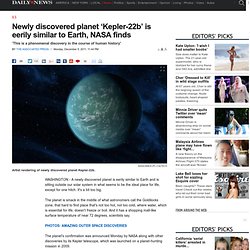
WASHINGTON - A newly discovered planet is eerily similar to Earth and is sitting outside our solar system in what seems to be the ideal place for life, except for one hitch. It's a bit too big. The planet is smack in the middle of what astronomers call the Goldilocks zone, that hard to find place that's not too hot, not too cold, where water, which is essential for life, doesn't freeze or boil. And it has a shopping mall-like surface temperature of near 72 degrees, scientists say. New Planet Discovered by NASA; Kepler-22b Might Support Life. New habitable planet! The view from Kepler 22b. - ComPost. Hello there!

(AP Photo/NASA/Ames/JPL-Caltech)Two astronomers are staring into a telescope, aimed 600 lightyears away. “A new planet!” They exclaim. “Blue. Tranquil. “And it’ll only take us 22 million years to reach it,” one of them adds. ”Maybe it’s inhabited already,” the first astronomer observes. They sigh. “Maybe,” the first one says. “Maybe.” “Maybe, over there, blankets with sleeves that let you change the channel without the tiny amount of movement required to pull your limbs out from under the blanket are not a major sector of the economy.” “Maybe they don’t have that mad rush for holiday sales that results in people being trampled and pepper-sprayed.”
“Maybe they are less paranoid about sexting.” “Maybe they have figured out how to deal with income inequality, and there are no longer people tenting in their public spaces.” The Promise of Kepler-22b. NASA's Kepler Mission Announces Latest Planetary Discovery. NASA finds new planet Kepler 22b outside solar system with temperature right for life. Spied by NASA’s Kepler space telescope, Kepler-22b marks the best candidate yet for a life-bearing world beyond our solar system, project scientists said Monday.

If it has a surface, it ought to have a nice temperature,” said Kepler’s lead scientist, Bill Borucki, during a teleconference Monday. “It’s right in the middle of the habitable zone,” said Natalie Batahla, a Kepler scientist, referring to the narrow, balmy band of space around any star where water can be liquid. “The other exciting thing is that it orbits a star very, very similar to our own sun.” The actual temperature on Kepler-22b hinges on whether the planet has an atmosphere, which, like a blanket, would warm the surface.
Even without an atmosphere, Borucki said, the planet would likely be warm enough to host liquid water on its surface. If it has a surface. S Kepler Mission Confirms Its First Planet in Habitable Zone of Sun-like Star. Click image for multiple resolutions.
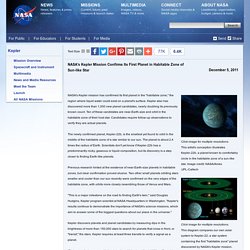
This diagram compares our own solar system to Kepler-22, a star system containing the first "habitable zone" planet discovered by NASA's Kepler mission. Image credit: NASA/Ames/JPL-Caltech NASA's Kepler mission has confirmed its first planet in the "habitable zone," the region where liquid water could exist on a planet's surface. Kepler also has discovered more than 1,000 new planet candidates, nearly doubling its previously known count. Ten of these candidates are near-Earth-size and orbit in the habitable zone of their host star. Candidates require follow-up observations to verify they are actual planets. S Kepler Confirms Its First Planet in Habitable Zone of Sun-Like Star. RELEASE : 11-408 NASA's Kepler Confirms Its First Planet in Habitable Zone of Sun-Like Star MOFFET FIELD, Calif. -- NASA's Kepler mission has confirmed its first planet in the "habitable zone," the region where liquid water could exist on a planet’s surface.
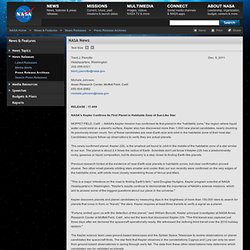
Kepler also has discovered more than 1,000 new planet candidates, nearly doubling its previously known count. Ten of these candidates are near-Earth-size and orbit in the habitable zone of their host star. Candidates require follow-up observations to verify they are actual planets. The newly confirmed planet, Kepler-22b, is the smallest yet found to orbit in the middle of the habitable zone of a star similar to our sun. The planet is about 2.4 times the radius of Earth. Previous research hinted at the existence of near-Earth-size planets in habitable zones, but clear confirmation proved elusive. Comfortably Circling within the Habitable Zone.
Kepler-22b -- Comfortably Circling within the Habitable Zone This diagram compares our own solar system to Kepler-22, a star system containing the first "habitable zone" planet discovered by NASA's Kepler mission.
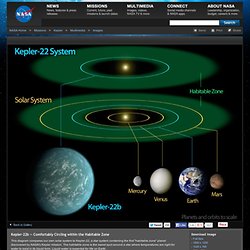
The habitable zone is the sweet spot around a star where temperatures are right for water to exist in its liquid form. Liquid water is essential for life on Earth. Closer to Finding an Earth. Kepler-22b: NASA discovers 'Earth-like' new planet (VIDEO) This handout illustration made available on December 5, 2011 by NASA, the Kepler-22b, a planet known to comfortably circle in the habitable zone of a sun-like star is digitally illustrated.
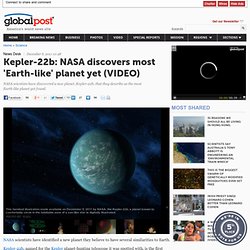
Please support our site by enabling javascript to view ads. NASA scientists have identified a new planet they believe to have several similarities to Earth. Kepler-22b, named for the Kepler planet-hunting telescope it was spotted with, is the first planet to be confirmed beyond our solar system in what the Guardian called the "Goldilocks zone:" not too hot, not too cold, and therefore possibly habitable.
The planet is 2.4 times the size of Earth. It orbits a star similar to the Earth's sun and is believed to have a surface temperature of around 22 degrees Celsius, according to NASA. Kepler-22b could be inhabited - Science - News. The planet, Kepler-22b, is about twice the size of Earth and may have a surface temperature of around 22C - similar to a warm spring day in the UK.

It is the first so-called "super-Earth" known to lie within the "habitable" zone of a Sun-like star. Dubbed the "Goldilocks zone", this is the orbital band where temperatures are just right to allow the existence of surface liquid water. This means the planet could have continents and oceans just like the Earth. And where there is liquid water, there could also be life. Scientists believe Kepler-22b may not only be habitable, but possibly even inhabited. "This discovery supports the growing belief that we live in a universe crowded with life," said Dr Alan Boss, from the Carnegie Institution in Washington DC, who helped identify the planet from data obtained by the Kepler space telescope.
Kepler-22b. Discovery and observation[edit] The planet's first transit in front of its host star was observed on Kepler's third day of scientific operations, in 12 May 2009.[11] The third transit was detected in 15 December 2010.
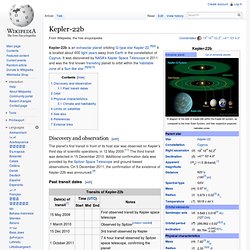
Additional confirmation data was provided by the Spitzer Space Telescope and ground-based observations. On 5 December 2011, the confirmation of the existence of Kepler-22b was announced.[9] Past transit dates[edit] Orbit[edit] The only parameters of the planet's orbit that are currently available are its period, which is about 290 days, and its inclination, which is approximately 90°, so that it transits the disk of its star as seen from Earth. Kepler-22b. Kepler-22b. Kepler 22b: probably not home to interesting aliens. A verdant paradise? Or just covered in bacterial pond slime? Who knows. (Artist's impression) The excitingly named Kepler 22b, a planet believed to have been discovered orbiting a star a mere 600 light years away, is being hailed as a "New Earth".
But sci-fi fans shouldn't get too excited just yet: as always with these stories, the likelihood is that we have not met the neighbours. I spoke to Dr Lewis Dartnell, of the Centre for Planetary Sciences at UCL, about how likely it is that there is life, or better yet intelligence, on Kepler 22b. There are efforts to find more data. "If one or two of them have oxygen in the atmosphere, it may be a transient thing – like Venus, undergoing a runaway greenhouse effect – but if we find, say, 20 Earth-like planets,all with the signature of oxygen in their atmosphere, then that would be very unlikely. So, as yet, we don't know. That's not to say it wouldn't be incredibly exciting to find even a bacterial ET.
Kepler 22b - the 'new Earth' - could have oceans and continents, scientists claim. Exoplanet Kepler 22b: why do these planets get such dull names?